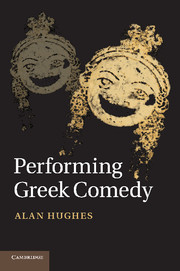Book contents
- Frontmatter
- Contents
- Illustrations
- Preface
- Chapter 1 Comedy in art, Athens and abroad
- Chapter 2 Poets of Old and Middle Comedy
- Chapter 3 Theatres
- Chapter 4 The comic chorus
- Chapter 5 Music in comedy
- Chapter 6 Acting, from lyric to dual consciousness
- Chapter 7 Technique and style of acting comedy
- Chapter 8 The masks of comedy
- Chapter 9 Costumes of Old and Middle Comedy
- Chapter 10 Comedy and women
- Chapter 11 New Comedy
- Catalogue of objects discussed
- Notes
- Glossary
- Bibliography
- Index
Chapter 7 - Technique and style of acting comedy
Published online by Cambridge University Press: 05 February 2012
- Frontmatter
- Contents
- Illustrations
- Preface
- Chapter 1 Comedy in art, Athens and abroad
- Chapter 2 Poets of Old and Middle Comedy
- Chapter 3 Theatres
- Chapter 4 The comic chorus
- Chapter 5 Music in comedy
- Chapter 6 Acting, from lyric to dual consciousness
- Chapter 7 Technique and style of acting comedy
- Chapter 8 The masks of comedy
- Chapter 9 Costumes of Old and Middle Comedy
- Chapter 10 Comedy and women
- Chapter 11 New Comedy
- Catalogue of objects discussed
- Notes
- Glossary
- Bibliography
- Index
Summary
Physical characterization
Tragic acting was governed by the ideal of sophrosyne, which comedy turned upside-down. ‘The physical appearance of the actor was fundamental to the presentation of comedy’, Green explains, because his face and figure are ‘anti-types of the ideal, free, citizen male’. From vase scenes and figurines, we can reconstruct the comic actor's preposterous appearance. Apparently taking it for granted, the play-texts rarely refer to it. He was usually represented as a man with a fat stomach, protuberant buttocks and grotesquely oversized phallos, all simulated by a metatheatrically artificial ‘undercostume’ representing his naked body which was inadequately covered by an indecently short chiton. For female roles the undercostume was hidden beneath normal contemporary dress, but until the later fourth century many female masks, and virtually all males, were grotesque inversions of society's ideals, both of regular features and imperturbability. Bulging eyes, a gaping mouth and flattened nose, large ears, warts, wrinkles and disordered hair all suggested inferior human types in states of extravagant excitement: ‘given their physical appearance, they could not be expected to behave properly, within society's normal codes’.
Dramatic dialogue often contains verbal stage directions that tell an actor what must be done:
- Type
- Chapter
- Information
- Performing Greek Comedy , pp. 146 - 165Publisher: Cambridge University PressPrint publication year: 2011

